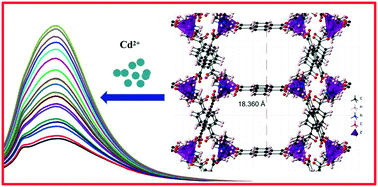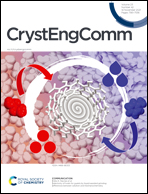Cation exchange in a fluorescent zinc-based metal–organic framework for cadmium ion detection†
Abstract
The anion zinc-based metal–organic framework [HDMA]2n[Zn2n(DMA)2n(1,4-BDC)3n]·2nDMF·6nH2O (1, DMF = N,N-dimethylformamide, 1,4-H2BDC = 1,4-benzenedicarboxylic acid, DMA = dimethylamine) with open channels has been used as a luminescent sensor for Cd2+ detection, and was obtained by solvothermal synthesis and fully characterized. It shows excellent fluorescence stability in aqueous solution, which was further enhanced with a remarkable fluorescence shift upon introduction of Cd2+, while negligible effects occurred for Fe2+, Zn2+, Fe3+, Cu2+, Co2+, Ni2+, Mn2+ and Pb2+, respectively. The detection limit is 9.9 μM with a linear range between 50 and 600 μM for Cd2+. Furthermore, it can be used to detect Cd2+ in tap water and rice samples directly. Solid state 13C NMR spectra give direct evidence for the ion exchange between protonated dimethylamine and Cd2+ hydrates, which results in the increase of fluorescence and blue shift of the wavelength. The coordination of Cd2+ with the carboxyl groups of 1 in the interface of nano-channels can be also observed using IR spectra, where a structural model has been suggested in the confined channels. This may provide a new construction method for anion fluorescent MOF materials, where a confined sample has obvious influence on the detection of Cd2+. The maximum adsorption capacities are 10.36, 54.53, 103.06 and 8.78 mg g−1 for CH4, CO2, O2 and N2 at 30 bar respectively.

- This article is part of the themed collection: Nanomaterials


 Please wait while we load your content...
Please wait while we load your content...